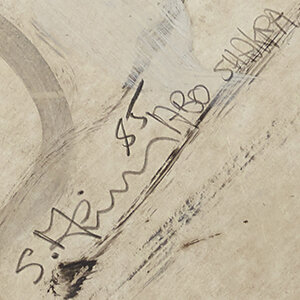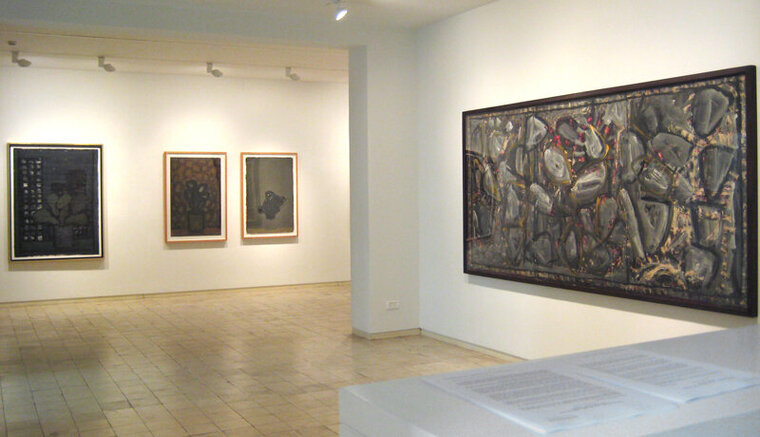


Last updated on Tue 5 May, 2020


Asim Abu Shaqra
12 Decemeber 2013 - 11 January 2014
Chelouche Gallery for Contemporary Art
Asim Abu Shaqra
Artist Book Launch
In conjunction with Solo Exhibition
Asim Abu Shaqra, the gifted young Israeli-Palestinian painter who died at the age of twenty-eight (1961-1990), has left behind a statement that is as lucid, self-contained, and authentic as it is splendidly and poignantly beautiful. The comprehensive book of Asim Abu Shaqra, published by the prestigious Charta Publishing, Italy, includes 200 pages with 115 colored illustrations. It provides the space for new interpretations on his paintings by three eminent art scholars: Tal Ben-Zvi, Kamal Boullata, and W. J. T. Mitchell, and includes an introduction by the editor Nira Itzhaki and a moving preface by Anton Shammas. (Language: English).
To mark the occasion of this book launch Chelouche Gallery will open an exhibition of Asim Abu Shaqra's work, which focuses on the sabbar motif. As one weaves the landscape of one’s homeland into being, Asim's paintings of the sabra were in effect self-portraits tethered into Palestinian iconography.
In the Image of His Homeland
“Someone had to move the sabbar, the cactus, to a flowerpot.” This is how Anton Shammas opens his wonderful preface to Asim Abu Shaqra | عاصم أبو شقرة book, and this is the task that Asim Abu Shaqra has performed over and over again in his paintings, in a kind of obsession arrested only by his untimely death.
Asim Abu Shaqra was born in Umm el-Fahm on November 11, 1961 to a Muslim family as the seventh out of ten children. On April 5, 1990 he died from severe illness at the young age of twenty-eight.
Even as a child Asim took to painting, but his decision to leave Umm el-Fahm for Tel Aviv at the age of eighteen in order to study painting was perceived in his social milieu as bold and revolutionary. He studied at the Tel Aviv School of Art and subsequently taught there as well. Yet throughout the entire course of his professional life—which was as intensive as it was brief—he was haunted by a sense of foreignness and unbelonging.
Asim was a tender-hearted, sensitive and noble painter, a handsome young man with a sense of humor and a cynical take on life bordering on the sarcastic, and yet he was at the same time a humanist who identified with the other, the sufferer, the outcast. Although he was very quickly inducted into the consensus of Israeli art, Asim retained a deep sense of affinity and commitment to the place he came from. He lived with a dialectical identity of contradiction and conflict between his Arab and Israeli affiliations, between his family tradition and his connection with contemporary art. All these tensions stirred in him a constant restlessness and found expression in his art. Despite the complexity in which he lived, Asim Abu Shaqra remained at bottom faithful to the place he came from, as manifested in his obsessive preoccupation with the sabra.
One weaves the landscape of one’s homeland into being, and whenever Asim painted the sabra he was in effect creating a self-portrait tethered to Palestinian iconography. Asim, who never went beyond the borders of this country, was a man of this place. He was always connected to the local culture, environment, and aesthetics, whether in Tel Aviv or in Umm el-Fahm. He took the sabra—a Palestinian symbol—with him to Tel Aviv and never stopped painting it. In the last two years of his life, as he was struggling with a malignant disease, Asim painted, over and over again, the sabra plant uprooted from its natural environment and planted as a foreign sapling in a flowerpot, and the approaching end of his life stimulated his concentration, thematic condensation, and sense of uplift.
It is extremely rare for a twenty-eight year old painter to attain such a mature and complete level of expression. It is safe to say that Asim Abu Shaqra has left behind a statement that is as lucid, self-contained, and authentic as it is splendidly and poignantly beautiful.
My personal acquaintance with the artist and his work, as well as my friendship and ongoing dialogue with his family, have driven me in the spring of 2000, a decade after his death, to take upon myself the project of publishing a comprehensive and serious book about his work. My aim was to take a fresh look at his work and to provide the space for new interpretations by three eminent art scholars: Tal Ben-Zvi, Kamal Boullata, and W. J. T. Mitchell. Thirteen years have gone by and the project is finally materializing.
- From the introduction by the editor Nira Itzhaki
Acknowledgments:
I am immensely thankful to artist family, and especially to Asim’s brother, Mohammed Abu Shaqra, for their trust and cooperation.
Jonathan Kolber, a dear friend and true lover of art who gave this project his unswerving support out of real generosity and unmitigated trust, made this book possible. I am deeply grateful to him, for without him all this would have remained no more than a dream.
My thanks go to Avraham Hai, who photographed the comprehensive collection of Asim Abu Shaqra’s work with love and unending devotion, and who was a real partner and companion to me all along the way.
Special thanks go to Tal Ben-Zvi, Kamal Boullata, and W. J. T. Mitchell for their thorough research, and to Anton Shammas for his moving preface to the book.
I thank Dina Shoham, the designer of the book, and to Asaf Kedar who translated and edited the texts, for their professional and accurate work.
I thank Adi Artsi and Dafna Falk from Chelouche Gallery and to Tali Rapaport for their accompaniment and support.
I thank Ahuva Ashman for her help and cooperation.
Finally, I would like to thank Charta Art Books in Milan for their collaboration in bringing the book to publication.
Asim Abu Shaqra was born in Umm el-Fahm on November 11, 1961 to a Muslim family as the seventh out of ten children. At the age of eighteen he moved to Tel-Aviv, studied at Kalisher-The Tel Aviv School of Art, and subsequently taught there as well. On April 5, 1990 Asim Abu Shaqra died from severe illness at the young age of twenty-eight. Asim Abu Shaqra has had solo exhibitions at Rap Gallery, Tel Aviv (1988, 1989), Cabri Gallery, Kibbutz Cabri (1990), Israel Museum, Jerusalem (1991), Tel Aviv Museum of Art, Tel Aviv (1994), and at Chelouche Gallery for Contemporary Art (2013), and also participated in numerous group exhibitions in Israel and abroad. His works are in important collections at the Tel Aviv Museum, Israel Museum, Jonathan Kolber Collection.
Asim Abu Shaqra
Artist Book
2013
Charta Publishing, Milan
Edited by Nira Itzhaki, Chelouche Gallery
A symposium at Asim Abu Shaqra's solo exhibition, with the participation of Farid Abu Shakra, Tal Ben Zvi and Muhammad Jabali, 11.01.2014
Join us in our endless discovery of modern and contemporary Arab art